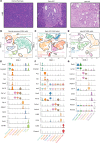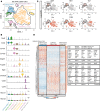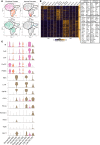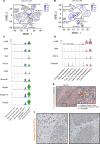Cellular heterogeneity during mouse pancreatic ductal adenocarcinoma progression at single-cell resolution
- PMID: 31335328
- PMCID: PMC6777805
- DOI: 10.1172/jci.insight.129212
Cellular heterogeneity during mouse pancreatic ductal adenocarcinoma progression at single-cell resolution
Abstract
Pancreatic ductal adenocarcinoma (PDA) is a major cause of cancer-related death with limited therapeutic options available. This highlights the need for improved understanding of the biology of PDA progression, a highly complex and dynamic process featuring changes in cancer cells and stromal cells. A comprehensive characterization of PDA cancer cell and stromal cell heterogeneity during disease progression is lacking. In this study, we aimed to profile cell populations and understand their phenotypic changes during PDA progression. To that end, we employed single-cell RNA sequencing technology to agnostically profile cell heterogeneity during different stages of PDA progression in genetically engineered mouse models. Our data indicate that an epithelial-to-mesenchymal transition of cancer cells accompanies tumor progression in addition to distinct populations of macrophages with increasing inflammatory features. We also noted the existence of three distinct molecular subtypes of fibroblasts in the normal mouse pancreas, which ultimately gave rise to two distinct populations of fibroblasts in advanced PDA, supporting recent reports on intratumoral fibroblast heterogeneity. Our data also suggest that cancer cells and fibroblasts may be dynamically regulated by epigenetic mechanisms. This study systematically describes the landscape of cellular heterogeneity during the progression of PDA and has the potential to act as a resource in the development of therapeutic strategies against specific cell populations of the disease.
Keywords: Cancer; Gastroenterology; Oncology.
Conflict of interest statement
Figures






References
-
- Kleeff J, et al. Pancreatic cancer. Nat Rev Dis Primers. 2016;2:16022. - PubMed
Publication types
MeSH terms
Grants and funding
LinkOut - more resources
Full Text Sources
Other Literature Sources
Medical
Molecular Biology Databases

